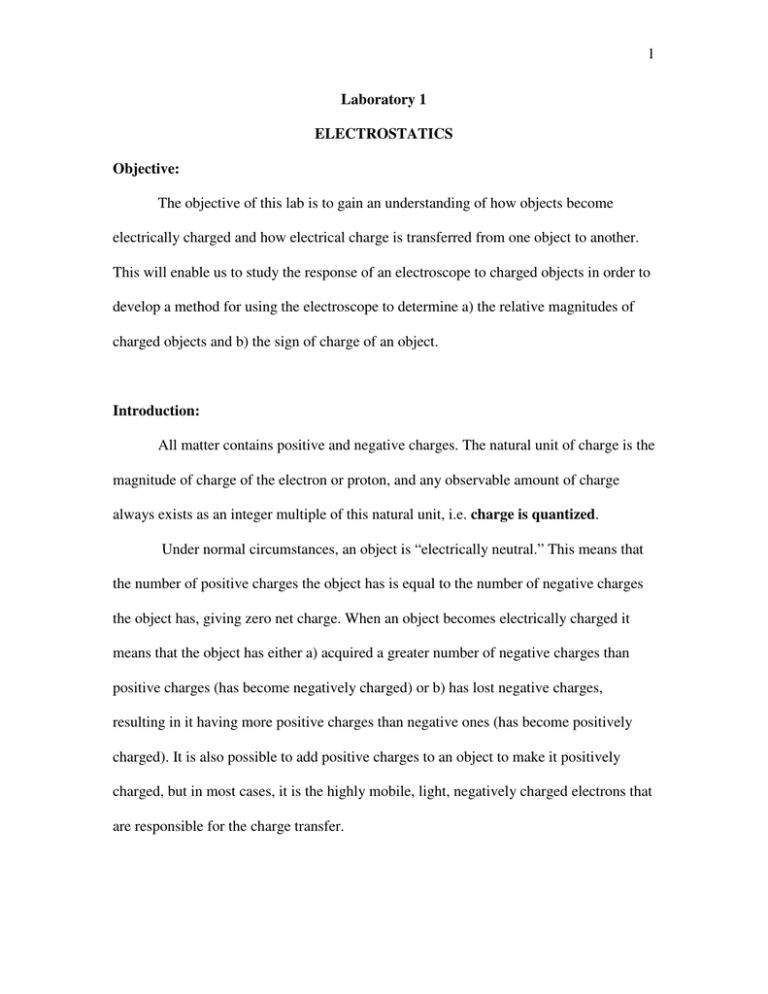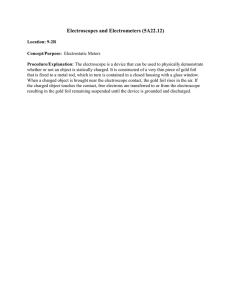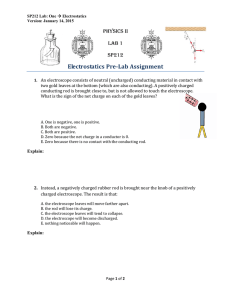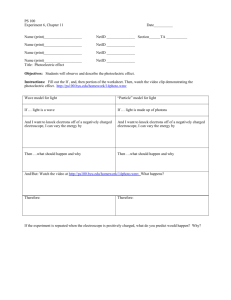1 Laboratory 1 ELECTROSTATICS Objective: The objective of this
advertisement

1 Laboratory 1 ELECTROSTATICS Objective: The objective of this lab is to gain an understanding of how objects become electrically charged and how electrical charge is transferred from one object to another. This will enable us to study the response of an electroscope to charged objects in order to develop a method for using the electroscope to determine a) the relative magnitudes of charged objects and b) the sign of charge of an object. Introduction: All matter contains positive and negative charges. The natural unit of charge is the magnitude of charge of the electron or proton, and any observable amount of charge always exists as an integer multiple of this natural unit, i.e. charge is quantized. Under normal circumstances, an object is “electrically neutral.” This means that the number of positive charges the object has is equal to the number of negative charges the object has, giving zero net charge. When an object becomes electrically charged it means that the object has either a) acquired a greater number of negative charges than positive charges (has become negatively charged) or b) has lost negative charges, resulting in it having more positive charges than negative ones (has become positively charged). It is also possible to add positive charges to an object to make it positively charged, but in most cases, it is the highly mobile, light, negatively charged electrons that are responsible for the charge transfer. 2 An important principle to understand is that charge is conserved. This means that charge is not created or destroyed, but rather transferred from one object to another. The easiest way to charge two materials is to rub them together. Depending on the relative affinity (or attraction) for electrons of the two materials, one object will end up gaining electrons (that is, electrons will be transferred to this material from the other and hence become negatively charged) and the other one, since it loses electrons, will become positively charged. The clear strip in this lab (cellulose acetate) becomes positively charged when rubbed with a cloth, and the white strip in this lab (polythene) becomes negatively charged when rubbed with a cloth. Electric charges have the property that like charges repel and opposite charges attract. Specifically, two positive charges or two negative charges repel, whereas a positive charge and a negative charge attract. In terms of electrical conductivity, materials can be categorized into two categories: conductors and insulators. Conductors are materials which permit electric charge to flow freely from one part of the material to the other, while insulators do not allow free flow of charge. In general, metals are conductors and nonmetals are insulators. To study electric charge in this laboratory, we will be using an electroscope, which produces a visible response to the presence of an electric charge. Electroscope: The rod, R, connects the electrode, C, to the gold leaf, L. The rod is insulated from the metal casing by the insulator, I. 3 Charging the Electroscope by Conduction When a negatively charged object is brought into contact with the electrode, negative charge flows from the object to the electrode. This charge then becomes distributed over the electrode, the rod, and the leaf. Since the charge on the rod and the leaf is of the same sign, the leaf will be repelled and hence deflected away from the rod. A larger charge will cause a larger deflection, but the relationship is nonlinear and difficult to use quantitatively. When a positively charged object is brought into contact with the electrode, negative charges flows from the electrode to the object, which also causes the leaf to be deflected away from the rod. To remove the charge on (or “ground”) the electroscope, touch the electrode with your finger. Charging the Electroscope by Induction When a charged object is brought near an uncharged electroscope, the object will cause a separation of charges between the electrode and the bottom of the rod. For a positively charged object, electrons in the electroscope will be attracted to the object and gather on the electrode, leaving a net positive charge at the bottom of the rod and the leaf. For a negatively charged object, electrons in the electroscope will be repelled from the object and gather at the bottom of the rod and the leaf, leaving the electrode and the top of the rod positively charged. In either case: 1) The charged object has “induced” a charge at the bottom of the electroscope, and 2) the induced charge causes the leaf to deflect. 4 Experimental Apparatus: - electroscope - clear strip of cellulose acetate - white strip of polythene - cloth - polythene plate - metal disks with insulating handles - metal can Experimental Procedure: Part A: Electroscope Response For this part of the experiment, observe and carefully record how the gold leaf moves during each of the following steps, and the amount of deflection of the gold leaf at the end of each step. Show, by the use of supporting diagrams, what you think the charge on the gold leaf is at the end of each step. 1. Ensure your electroscope is grounded. (The gold leaf should be hanging straight down.) 2. Charge the white strip rubbing it with the cloth provided. 3. Bring the white strip near the electrode and ground the electroscope. What happens to the gold leaf? 4. Slowly pull the strip away. 5. Slowly bring the strip near the electrode again. 5 6. Slowly pull the white strip away and bring the clear strip near the electroscope. What happens to the gold leaf? 7. Interchange the strips and repeat the above 6 steps. Discussion: Based on your observations, 1) Discuss a procedure for determining the sign of an unknown charge on the gold leaf using either one of the two strips. Use diagrams to illustrate the imbalance of charge to support your response. 2) Discuss a procedure for determining the sign of the charge on an object by using the electroscope and the white strip, using diagrams to support your response. Part B: Testing the Sign of an Unknown Charge 1. Momentarily ground the electroscope. 2. Touch the flat part of the (negatively-charged) white strip to the electrode and remove the strip. If a charge remains on the electroscope, determine the sign of the charge on the electroscope. 3. Charge the polythene plate by rubbing it. Pick up the large metal disk by the insulating handle and place it on top of the polythene plate. Ground the top of the metal disk with your finger then pull the disk away. What is the sign of the charge on the metal disk? Draw diagrams to support your answer. 4. Place the metal disk on top of the electroscope. What happens to the gold leaves? What is the sign of the charge on the gold leaves? 6 5. Remove the metal disk and continue repeating steps 3 and 4 to increase the deflection of the leaves of the electroscope. Results and Discussion: Draw diagrams representing each step of your procedure, indicating the sign of the charge that each object attains. Discuss a possible mechanism for charging the electroscope that is consistent with the results of your experiment. C. Exploring Charge Distributions 1. Charge the polythene plate by rubbing it and then place the large metal disk on top of the polythene plate. 2. Momentarily ground the top of the disk. Pick up the disk with the insulating handle and place it on its side on an insulating surface so that both the top and bottom of the disk are accessible. 3. Bring the small disk into contact with the large disk. The small disk will pick up a charge that is proportional to the surface charge density of the large disk at the point of contact. 4. Put the small (now charged) disk on top of the electroscope, and note the size of the deflection of the gold leaf. Ground the electroscope. 5. Explore the distribution of charge on the large disk by repeating steps 3 and 4 for several different contact spots on the large disk, being sure to include both sides and points near the rim and near the centre. Where is the charge on the large disk most concentrated? Where is it least concentrated? 7 6. Explore the charge distribution of the metal can by first charging the metal can with the large disk (as in Part B), and then using the small disk to determine the regions of high and low charge concentration. Results and Discussion: Describe the charge distribution for the large disk and the metal can. Why is the charge distributed in the way that you observed? D. Exploring Transfer of Charge 1. Place the metal can on the grounded electroscope. Charge the small disk (as in Part B) and contact the small disk to the inside of the can. Repeat this many times. Is there any change in deflection of the electroscope? 2. Repeat step 1, except touch the small disk to the outside of the can. Results and Discussion: Note any changes in deflection of the electroscope. Where is the charge going and how can you tell? Is it possible to transport charge from a weakly charged object to a strongly charged object using this method?



